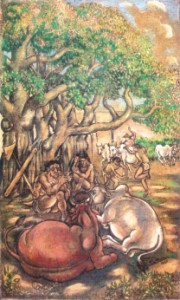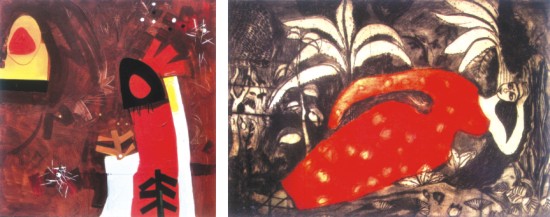|
Art
Bengal Gallery's Veritable Gems
Fayza Haq

L-R: Quamrul Hassan, Three Faces, water colour on paper, 24x33cm, 1982.
Zainul Abedin, Mexico, pen and ink on paper, 36x28cm, 1956.
Bengal's earlier programmes to mark its 10th anniversary have always been something to talk about. Yet the October 9th exhibition of works of old masters and senior painters was certainly the most spectacular. Breathtaking as was the experience of viewing it, one felt transported into a dream world which one never forgets. The collection contained colours, lines, styles and subjects that made it nonpareil. Names such as those of SM Sultan, Zainul Abedin, Safiuddin Ahmed, and Quamrul Hasan made it a star-studded endeavour. Contemporary masters such as Aminul Islam, Qayyum Chowdhury, Rafiqun Nabi, Rokeya Sultana and Farida Zaman added to its attraction. Viewers and critiques thronged the gallery two days before the opening.
SM Sultan's larger than life images of farmers and cattle, the rippling muscles of the figures done in earthy colours and the large swelling bellies and cows spoke of the artist's vision of a world of plenty in Bengal. The painting was in earthy colours, emerald green and dramatic jet-black. The elements of peace, harmony pervaded the entire massive canvas.
 |
S M Sultan, Untitled, oil on jute canvas, 153x92cm, 1987. |
Zainul Abedin's watercolours were placed as the prelude of the symphony. The first piece by Zainul Abedin, detailed a standing figure of a foreigner seen during the artist's sojourn there. Hat, jacket, walking stick was brought with swift and deft strokes. The focus of another picture was a birdhouse on a tree. Included was a surrounding wall. This and other sepia sketches brought figures and forms from gone by days. These were amalgamated with other soft, subtle forms, like a tree and grass.
Several of Qamrul Hasan's paintings were included in the display. The main one was the well-known scene of the countryside, with two women chatting and exchanging news and views of their village; and the world connected with it. The oval and rounded, quick, definite strokes presented the figures in simple and graceful saris – with the details of the borders of the saris. The colours were eye-catching, as were the lines that had been used. They brought in idealised figures in white and soft shades – as well the surrounded grass – with an idyllic poetic touch.
Safiuddin Ahmed's oil painting depicted cattle with curved horns in such a manner that they appeared to be wings of a bird or the wings of butterfly. The human figure was seen in geometrical form. The background remained a dusky amalgamation of dusky green and blue. Shades of umber and cobalt blue had been used on the canvas that appeared to have a life and spirit of its own. Passionate and dramatic – the oil painting was bursting with joie de vivre.
His well-known prints, with black and white mystic beauty of their own, confirmed the giant of printmaking – who towered over others in his time – and even now, decades later. His energy and passion for work, his imagination and drive have never been surpassed. The oldest living artist of Bangladesh Safiuddin Ahmed has brought scenes from a journey through the thickest of a forest. We see the rider in a “dhoti' shaded by an umbrella, with servants and a dog in this dappled print of the peaceful past. The play of light and shade in this print and the other one containing a Bengal flood scene is magnificent. Even with a subject such as the devastating natural disaster in mind, the master artist had brought in a scene with fleeing people, the marauding flood and fleeing people with an element of repose. A similar scene by the younger artists today will contain colours and lines that tend to shock, as a rule.
Mohammed Kibria, the master of abstraction, has always been a unique printmaker and painter. As the second senior-most living artist of Bangladesh, his ideas are westernised and quite avante garde. His concept of life is that peace and success is through the worship of the creator – no mater of what colour, race or religion people may be. His attitude has always had a global approach. He has never been hemmed in by time and space. He has always protested against those greedy for money and land – causes for conflicts between countries, throughout history. In his piece we see geometrical shapes of land. The rectangular forms could be taken as segments of man's life, or meaning for living. These were divided into pink, gray and other earthy colours, one layer put upon another. A single black line ran through the centre to heighten the effect.
 |
 |
Safiuddin Ahmed, On the Way to the Fair, wood engraving
on paper, 16x20cm, 1947. |
Iftikhar Uddin Ahmed, Past and Present, Acrylic
on canvas
160x178cm, 2010. |
Aminul Islam, who had a successful solo at “Chitrak” recently, contained poised and soothing declinations of women. They had muted hues. One contained a woman in a beige jacket and dark skirt; the other presented a Bengali lady with her servant carrying a jar of water, her child with her. They appeared stylised and restful and deified womanhood.
Abdul Baset brought in the woman image; one saw the not so glorified woman. She was the average woman but she had a dreamy languor. With a simple nose and smiling lips she is not the perfect, idealised mother but an honest representation of a village mother. The use of many colours in the delineation enhanced the appeal of the picture. A number of studies have been put together with the same model. One must appreciate the subtle dramatic strokes.
Samajit Roy Chowdhury, an expert painter by all standards, brought in the beauty of the countryside with aplomb. The canvas had been divided with black divisions. The spaces in between had filled with symbols of the countryside. This included birds, animals, buntings, kites – which stood for happy memories, and his concept of the contemporary life around him in the claustrophobic cities.
Male and female figures have been included in gray, black and red in Abdul Shakoor's paintings these are always based on myths and legends from the countryside, of the past. Lips, nose-rings, necklaces and saris had been delineated in details. The basic colours of black and variations of tangerine had been used to bring in forms. There was also the signature calligraphy – the art lovers at home and from overseas admire. The combination of the neat panels into which the groups of figures had been placed lent neatness and harmony. Many younger painters, who learn from maestro like Shakoor have the same subjects in mind. Dots and dashes completed the superb creation.

L-R: Qayyum Chowdhury, Untitled, acrylic on canvas 90x90cm, 2010. Rokeya Sultana,
Bon Bibi, drypoint on paper, 66x98cm, 2006.
The inimitable style of Shahid Kabir – making the simple every day items seen on the kitchen table, or the garden outside – was there in the single hibiscus flower. Done in shades of scarlet, magenta and wine red, the flower was seen from the bottom. The pistil and other accompanying parts of the flower were also there for all to see and admire.
Few among the female professors with a doctorate degree, Farida Zaman brought in her recurring theme of the fisherwoman. They appeared to be exchanging news of their families and themselves. The painting in shades of orange and red appeared ever so appealing in the presentation of the fisherwomen – who appeared to be floating or dancing with the background of the waves. The bosoms and derrieres were stressed upon, as also the delicate limbs. They appeared like some mermaids or fairies from the writings of days gone by.
Similarly, draped in emotions and idyllic dreams concerning womanhood, was Rokeya Sultana's picture with the resting image of her “Madonna”. Her female form had flowing hair, and seductive details of face and slender limbs draped in a gorgeous, clinging garment. Done in magenta and white, the delicate lotus buds and flowers – which embroider the clothing and were included in the backdrop made the item, appear like some splendid Pre-Raphaelite work – seen in a contemporary angle.
Other delightful items like Kanak Champa Chakma's delightful presentation of Hill Tracts life, the hunters of the past, using ancient weapons, like massive bow and arrow using to hunt down black, overwhelming cattle was also there to behold. Tayyaba Begum Lipi, with her prize-winning piece was there too. Flaxen-haired tiny dolls had been superimposed on the visage of the protesting woman. Dilara Begum Jolly's symbolic creations, with their startling images in sharp, contrasting colours were there too. These went hand in hand with their more senior contemporary artists like Sayed Jehangir, with his river scene. This with the vast water expanse and the sky in scintillating cobalt blue and gold had been seen placed in the gallery too, for all to gaze and admire. Ghiasuddin Ahmed from Japan, with his sea creature or flower like image for the focal point, rounded up the mind-boggling exhibition.
Copyright
(R) thedailystar.net 2010 |
| |
